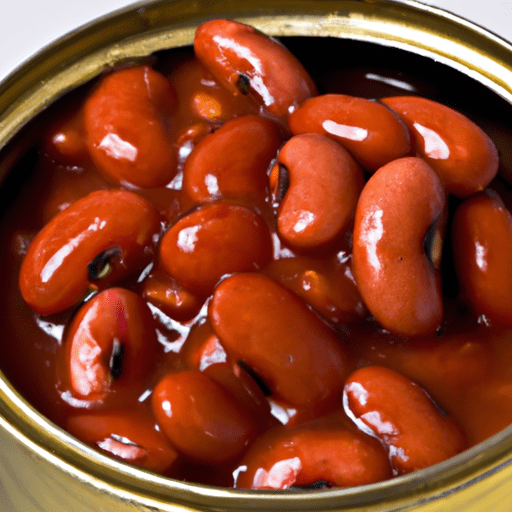Canned Great Northern Beans: A Versatile Pantry Staple
If you’re looking to enhance your culinary repertoire with a versatile pantry staple, look no further than canned Great Northern beans. These small, creamy white legumes are not only delicious but also packed with nutritional value. Whether you’re a seasoned chef or a beginner in the kitchen, these beans are a game-changer that can effortlessly elevate a wide range of dishes. In this blog post, we will explore the taste, common uses, nutritional value, and share some interesting facts about these delectable beans.
Taste and Texture
Great Northern beans have a mild, delicate flavor that makes them incredibly versatile. When cooked, they become tender and creamy, making them perfect for a variety of dishes. Their smooth texture pairs well with various seasonings and ingredients, allowing them to absorb and complement flavors from other ingredients in a dish.
Common Uses in Cooking
With their subtle flavor and creamy texture, canned Great Northern beans can be used in a multitude of dishes. Let’s explore some common uses:
Soups and Stews
Great Northern beans are a fantastic addition to soups and stews. Their ability to absorb flavors makes them an ideal ingredient for hearty, comforting dishes. Add them to a classic white bean soup with vegetables and herbs, or incorporate them into a savory stew along with your favorite meats and vegetables for a filling and nutritious meal.
Salads
These beans can also shine in vibrant salads. Toss them into a garden salad for an extra protein boost or create a refreshing bean salad with tomatoes, cucumbers, onions, and herbs. The creamy texture of the beans adds a delightful contrast to the fresh crunch of vegetables.
Dips and Spreads
Great Northern beans can be transformed into creamy dips and spreads. Whip them up with garlic, lemon juice, and olive oil for a delightful bean dip. You can also blend them with tahini and spices to create a delicious hummus alternative.
Pasta and Rice Dishes
These beans work wonders in pasta and rice dishes. Mix them into a pasta salad or use them as a filling for stuffed pasta shells. They can also be added to rice-based dishes like risottos, pilafs, or grain bowls for an extra dose of protein and texture.
Veggie Burgers
Great Northern beans can serve as the base for homemade veggie burgers. Mash them with breadcrumbs, spices, and vegetables to create a flavorful patty that’s both hearty and satisfying.
Nutritional Value
In addition to their versatility in the kitchen, Great Northern beans offer several health benefits:
- They are an excellent source of plant-based protein, making them an ideal choice for vegetarians and vegans.
- They are high in dietary fiber, promoting healthy digestion and aiding in weight management.
- Great Northern beans are rich in essential minerals like iron, potassium, and magnesium.
- They are low in fat and cholesterol, making them a heart-healthy food option.
Interesting History and Facts about Great Northern Beans
- Great Northern beans, also known as white kidney beans, are native to North America and have been cultivated for centuries by Native American tribes.
- The beans gained popularity in the United States during the 19th century and received their current name due to their widespread cultivation in the Great Northern region.
- These beans are one of the most common varieties used in the popular dish “baked beans.”
- Great Northern beans are often used in Italian cooking, particularly in dishes like Pasta e Fagioli and Minestrone soup.
In conclusion, canned Great Northern beans are a valuable pantry staple that can elevate your culinary creations. Their mild taste, creamy texture, and versatility in various dishes make them a go-to ingredient for both seasoned cooks and beginners. Whether you’re looking to add protein to your salads, create comforting soups, or make homemade veggie burgers, these beans are a reliable choice. So, next time you’re in the mood for a satisfying meal, reach for a can of Great Northern beans and let your creativity take over!
Interesting Facts about Canned Great Northern Beans:
Origin: Great northern beans (Phaseolus vulgaris) are native to North America and were originally cultivated by Native American tribes in the region. They are named after the Great Lakes region where they were commonly found.
Common Uses: Canned great northern beans are versatile legumes that can be used in a variety of dishes. They are commonly used in soups, stews, casseroles, and salads. Their mild flavor and creamy texture make them a popular choice for bean-based recipes.
Nutritional Benefits: Great northern beans are a nutrient-dense food, packed with various essential nutrients. They are an excellent source of dietary fiber, protein, and folate. They also contain significant amounts of iron, potassium, and magnesium. Great northern beans are low in fat and cholesterol-free.
Unique Properties: Great northern beans are oval-shaped and have a distinctive creamy-white color. They can hold their shape well, even after being cooked, making them ideal for dishes where you want the beans to remain intact. They have a mild, nutty flavor that pairs well with many other ingredients.
Historical Significance: Great northern beans have been a staple food for centuries. Native Americans used them as a significant part of their diet, often drying them and storing them to be used during winter months. European settlers introduced these beans to other parts of the world during the Columbian Exchange, leading to their cultivation and consumption globally. Today, they are widely recognized and enjoyed as a versatile pantry staple.




Use the share button below if you liked it.
It makes me smile, when I see it.